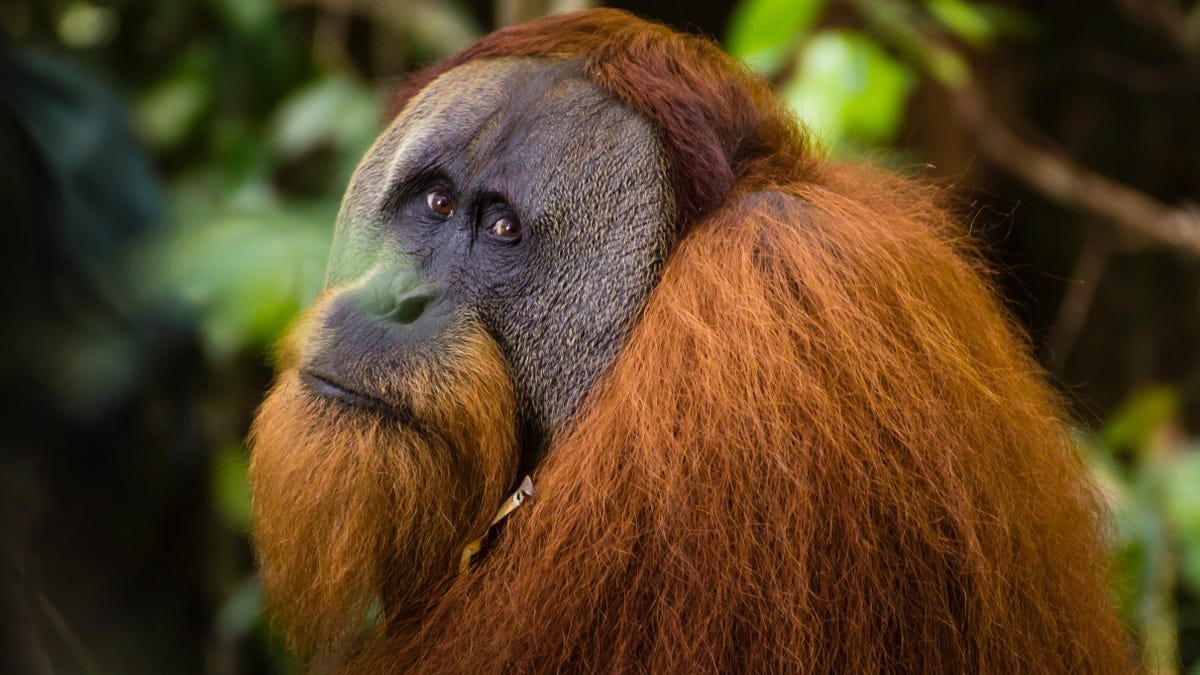Humans aren’t the only primates with a medicine cabinet, it seems. In a new paper published today, scientists document a male orangutan named Rakus using a plant with known medicinal properties to help heal his facial wound. While there have been other recent accounts of animals using medicine in the wild, this appears to be the first report of an animal applying plants to their wounds as a sort of topical salve, the authors say.
The sighting was captured by primate researcher Isabelle Laumer and her colleagues. Since 1994, the team has been studying the wild Sumatran orangutans (Pongo abelii) living at the Suaq Balimbing research site in Indonesia, a protected rainforest area home to about 150 orangutans.
During their daily rounds of observation in late June 2022, they came across Rakus, who was sporting a nasty wound on the right side of his flange (the thick cheek pads prominent in some males). The wound was likely obtained from a recent fight with a neighboring male. Three days after his wound appeared, Rakus did something that the researchers had never seen before. He ingested, chewed, and spit out bits of a nearby plant, then dabbed his wound with the resulting plant mix.
From all the evidence the team has gathered, the details of which were published Thursday in the journal Scientific Reports, it seems that Rakus knew exactly what he was doing.
For starters, Rakus only applied the plant to his wounds and nowhere else on his body. He also did it repeatedly and made sure to get enough solid plant pulp to cover up his entire wound—a process that took about seven minutes. He was then observed eating the plant again the next day.
The actual plant used by Rakus is called Fibraurea tinctoria, also known as Akar Kuning. The plant has long been used by humans in the region as a traditional medicine treatment for various conditions, while studies have identified ingredients in the plant that have antibacterial, anti-inflammatory, anti-fungal, and other helpful medicinal properties. But perhaps the most dramatic piece of evidence is that Rakus seemed to heal quickly following his plant treatment. Within five days, his wound had closed up, and by late August, it was barely noticeable.
There have been other reports of self-medicating being performed by animals in the wild, including other primates. In a 2022 study, for example, scientists documented chimpanzees grabbing flying insects from the air, chewing them up, and then applying the mix to their wounds or the wounds of other chimps in the group. Some animals have also been observed eating plants that might have painkilling or healing abilities. But this looks to be the first documented case of an animal actively treating their fresh wounds by topically applying a medicinal plant, the authors say.
There are still plenty of questions about the team’s discovery—including exactly how Rakus learned how to heal himself in the first place. The plant is rarely eaten by orangutans in the area, and in their decades of observation, the team has never seen any injured orangutan in Suaq try to use it in the same way as Rakus did (that said, injuries in the area don’t happen often).
Orangutan males do tend to move far away from home, and like all adults there, Rakus isn’t native to Suaq. So it is possible that he might have originally learned the behavior from observing others where he grew up. But it’s also possible that Rakus is simply a crafty and somewhat lucky orangutan.
“Individuals may accidentally touch their wounds while feeding on this plant and thus unintentionally apply the plant’s juice to their wounds,” Laumer, currently a postdoctoral researcher at the Max Planck Institute of Animal Behavior in Germany, told Gizmodo via email “As Fibraurea tinctoria has potent analgesic effects, individuals may feel an immediate pain release, causing them to repeat the behavior several times.”
Laumer’s team will continue to closely monitor the orangutans of Suaq to see if other members can pull off the same trick. In the meantime, they hope their research can help us appreciate our great ape cousins a bit better.
“Observing wound treatment with a medical plant in our closest relatives again points towards the similarities we share. We are more similar than different,” she said. “We hope this study raises awareness of their critically endangered status in the wild.”

